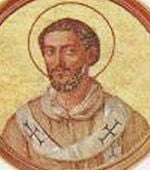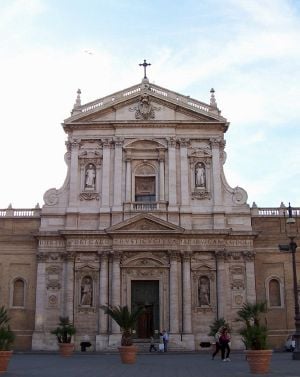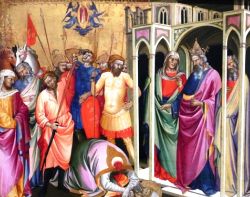Difference between revisions of "Pope Caius" - New World Encyclopedia
m |
m (→Biography) |
||
| Line 20: | Line 20: | ||
==Biography== | ==Biography== | ||
| − | [[ | + | [[Image:Santa Susanna (Rome) - facade.jpg|thumb|Site of the current Santa Susana in Rome, where Caius may have established an early Christian house-church]] |
Caius was said to have been born in the [[Dalmatia]]n city of [[Salona]], today known as Solin near [[Split]]. He was the son of a man also named Caius. According to a sixth-century account, two brothers named Caius and Gabinus, prominent and wealthy members of the Roman church, established an Christian house of worship in their house on the site of [[Santa Susanna]]. It it believed that this Caius may have the future pope, or [[Caius (presbyter)|Caius the Presbyter]]. Gabinus is the name given to the father of Saint Susanna. Thus, Pope Caius has been traditionally seen as the uncle of Saint Susanna. | Caius was said to have been born in the [[Dalmatia]]n city of [[Salona]], today known as Solin near [[Split]]. He was the son of a man also named Caius. According to a sixth-century account, two brothers named Caius and Gabinus, prominent and wealthy members of the Roman church, established an Christian house of worship in their house on the site of [[Santa Susanna]]. It it believed that this Caius may have the future pope, or [[Caius (presbyter)|Caius the Presbyter]]. Gabinus is the name given to the father of Saint Susanna. Thus, Pope Caius has been traditionally seen as the uncle of Saint Susanna. | ||
| − | + | ||
| − | |||
==Papacy== | ==Papacy== | ||
During his pontificate, [[anti-Christian]] measures increased, although new churches were built and cemeteries were expanded. St Caius may not have been martyred: Diocletian’s persecution of Christians began in 303 C.E., after Caius’ alleged death, and Diocletian was not immediately hostile to Christianity upon becoming emperor.<ref>[http://www.santiebeati.it/dettaglio/50400 San Caio]</ref><ref>[http://www.cfpeople.org/Books/Pope/popep28.htm St. Caius]</ref> As pope, he decreed that before someone could assume the position of [[bishop]], he must first be [[porter]], [[lector]], [[exorcist]], [[acolyte]], [[subdeacon]], [[deacon]], and [[priest]]. He also divided the districts of Rome among the deacons.<ref>[http://www.cfpeople.org/Books/Pope/popep28.htm St. Caius]</ref><ref>[http://www.saintpatrickdc.org/ss/0422.htm Saint Patrick's Church: Saints of April 22]</ref> | During his pontificate, [[anti-Christian]] measures increased, although new churches were built and cemeteries were expanded. St Caius may not have been martyred: Diocletian’s persecution of Christians began in 303 C.E., after Caius’ alleged death, and Diocletian was not immediately hostile to Christianity upon becoming emperor.<ref>[http://www.santiebeati.it/dettaglio/50400 San Caio]</ref><ref>[http://www.cfpeople.org/Books/Pope/popep28.htm St. Caius]</ref> As pope, he decreed that before someone could assume the position of [[bishop]], he must first be [[porter]], [[lector]], [[exorcist]], [[acolyte]], [[subdeacon]], [[deacon]], and [[priest]]. He also divided the districts of Rome among the deacons.<ref>[http://www.cfpeople.org/Books/Pope/popep28.htm St. Caius]</ref><ref>[http://www.saintpatrickdc.org/ss/0422.htm Saint Patrick's Church: Saints of April 22]</ref> | ||
Revision as of 20:15, 16 January 2009
| Saint Caius | |
|---|---|

| |
| Birth name | Caius or Gaius |
| Papacy began | December 17, 283 |
| Papacy ended | April 22, 296 |
| Predecessor | Eutychian |
| Successor | Marcellinus |
| Born | ??? ??? |
| Died | April 22, 296 ??? |
Pope Saint Caius or Gaius was Pope from December 17, 283 to April 22, 296. Christian tradition makes him a native of the Dalmatian and a member of a noble family related to the Emperor Diocletian. His history is clouded by later legend which associates him anachronistically with Saint Susanna and Saint Sebastian, who died during the persecutions of Diocletian after Caius' papacy had ended.
Little other information on Caius is available except that given by the Liber Pontificalis, which is not considered historically reliable. According to legend, Caius baptized the men and women who had been converted by Saint Tiburtius and Saint Castulus.
His legend states that Caius took refuge in the catacombs of Rome and died a martyr. However, as his episcopacy dates from a period of peace with the Roman state, this report is generally dismissed by modern scholars.
Biography
Caius was said to have been born in the Dalmatian city of Salona, today known as Solin near Split. He was the son of a man also named Caius. According to a sixth-century account, two brothers named Caius and Gabinus, prominent and wealthy members of the Roman church, established an Christian house of worship in their house on the site of Santa Susanna. It it believed that this Caius may have the future pope, or Caius the Presbyter. Gabinus is the name given to the father of Saint Susanna. Thus, Pope Caius has been traditionally seen as the uncle of Saint Susanna.
Papacy
During his pontificate, anti-Christian measures increased, although new churches were built and cemeteries were expanded. St Caius may not have been martyred: Diocletian’s persecution of Christians began in 303 C.E., after Caius’ alleged death, and Diocletian was not immediately hostile to Christianity upon becoming emperor.[1][2] As pope, he decreed that before someone could assume the position of bishop, he must first be porter, lector, exorcist, acolyte, subdeacon, deacon, and priest. He also divided the districts of Rome among the deacons.[3][4]
Tomb and burial
Caius is mentioned in the fourth-century Depositio Episcoporum (therefore not as a martyr): X kl maii Caii in Callisti.[5]
St Caius' tomb, with the original epitaph, was discovered in the catacombs of Callixtus and in it the ring with which he used to seal his letters (see Arringhi, Roma subterr., 1. iv. c. xlviii. p. 426). In 1631, his alleged residence in Rome was turned into a church. However, it was demolished in 1880 to make room for the Ministry of War, on the Via XX Settembre, and his relics were transferred to the chapel of the Barberini family.[6]
Veneration as a saint
Saint Caius's feast day is on April 22, as is that of Saint Soter. They are celebrated jointly in the Tridentine Calendar and in the successive versions of the General Roman Calendar until that of 1969, since when they are omitted. Both are mentioned under 22 April in the Roman Martyrology, the official list of recognized saints. The entry for Saint Caius is as follows: "At Rome, in the cemetery of Callistus on the Via Appia, the burial of Saint Caius, Pope, who, fleeing from the persecution of Diocletian, died as a confessor of the faith."[7]
St Caius is portrayed in art wearing the Papal Tiara with Saint Nereus. He is venerated in Dalmatia and Venice. In Florence, the Church of San Gaggio on the via Senese was dedicated to him. In 2003, plans were put into effect to turn it into residential council housing.[8]
| Roman Catholic Popes | ||
|---|---|---|
| Preceded by: Eutychian |
Bishop of Rome Pope 283–296 |
Succeeded by: Marcellinus |
Notes
- ↑ San Caio
- ↑ St. Caius
- ↑ St. Caius
- ↑ Saint Patrick's Church: Saints of April 22
- ↑ CATHOLIC ENCYCLOPEDIA: Caius and Soter
- ↑ San Caio
- ↑ Martyrologium Romanum (Libreria Editrice Vaticana, 2001. ISBN 8820972107)
- ↑ Firenze la città nuova - Gallery
ReferencesISBN links support NWE through referral fees
External links
 "Caius and Soter, Saints and Popes" in the 1913 Catholic Encyclopedia.
"Caius and Soter, Saints and Popes" in the 1913 Catholic Encyclopedia.- Opera Omnia by Migne patrologia Latina
- (Italian) San Caio
| ||||||||||||||||
| |||||||||||||||||||||||||||||||||||||||||||||
| |||||||||||||||||||||||||||||||||||||||||
Credits
New World Encyclopedia writers and editors rewrote and completed the Wikipedia article in accordance with New World Encyclopedia standards. This article abides by terms of the Creative Commons CC-by-sa 3.0 License (CC-by-sa), which may be used and disseminated with proper attribution. Credit is due under the terms of this license that can reference both the New World Encyclopedia contributors and the selfless volunteer contributors of the Wikimedia Foundation. To cite this article click here for a list of acceptable citing formats.The history of earlier contributions by wikipedians is accessible to researchers here:
The history of this article since it was imported to New World Encyclopedia:
Note: Some restrictions may apply to use of individual images which are separately licensed.



